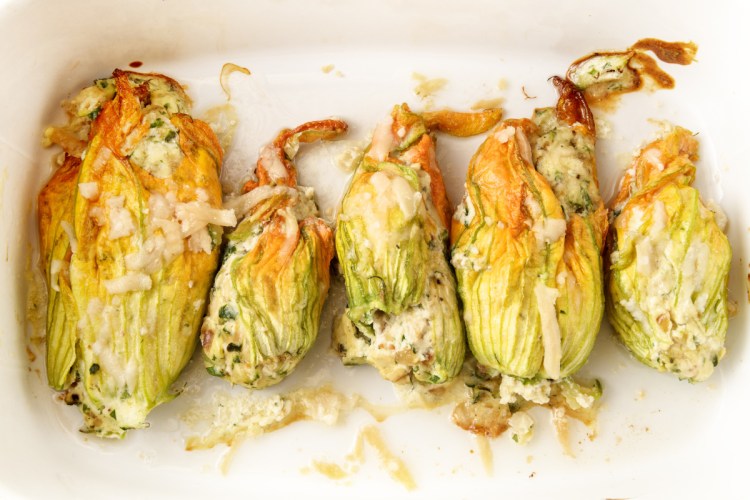While I was planting our vegetable garden early this spring, one of our neighbors passing by – our garden is on a shortcut from a major subdivision to the Cape Elizabeth school complex – asked if I had ever deep-fat fried squash blossoms.
That was a totally new concept for me. I’ve always just let the blossoms turn into zucchini or other types of squash and am happy to eat that.
I learned that fried squash blossoms are popular in both Italy and Mexico. The neighbor, who is of Italian descent, said his mother would dip them in batter and fry them in hot oil.

Zucchini blossoms fried in batter
If you are careful to pick only the male blossoms, you won’t even reduce the production of squash. Before picking, look to see if there is baby squash on the plant end of the blossom. Those are female, so avoid them (even though they taste just as good) so you don’t lessen your squash harvest.
Once you pick the blossoms, spread the petals and carefully remove the pistils, which requires some delicacy. And, maybe needle-nose pliers.
The blossoms can be stuffed with cheese or other ingredients before you fry them. Recipes for baking them exist if you want to avoid a few calories.
Squash blossoms – the most commonly used are zucchini, but any of them will work – are also edible raw. They can be added to a salad or filled with a soft cheese and eaten plain or added to the top of a crusty piece of bread.
Find links to recipes here and here.
A couple of weeks after learning about squash blossoms, I got an email from Kitchen Garden Seeds – a division of John Scheepers – offering a collection of seeds that produce edible flowers.

Johnny-jump-ups can be candied or frozen into ice cubes.
One that jumped out at me was Johnny-jump-ups, which are related to pansies. The little violas are volunteers, and we encourage them to grow in our vegetable garden. They are petite, colorful and good to eat. They are perennial, hardy to Zone 4, self-seeding and a cinch to grow, so if you don’t let them get crowded out by aggressive neighbors, you’ll have to plant them only once.
Johnny jump-ups are small, taste minty, and they can be candied or frozen into ice cubes.
That description of how to use the blossoms called to mind blue borage, which was on my list of colorful plants to try this gardening season. The borage has done quite well, despite neglect and tough weather, so I am calling it an easy flower to grow. Like the Johnny-jump-ups, borage is described as being good garnishes, able to be candied and good in ice cubes. They taste a bit like cucumbers.

Edible flower lists I found online include bachelor buttons, marigolds, calendula, nasturtiums, cornflower and hyssop.
These all are attractive; many can be used as cut flowers in addition to being eaten and enjoyed in the garden; and they are small. They will be garnishes, adding a touch of flavor and color to a salad.
Some of the edible flower lists also include chives – which I consider cheating. Chives are grown as food, and the fact that they have attractive, long-lasting blossoms is a bonus.
Back in the 1970s, when we and all of our friends were relatively poor, the standard appetizer was chives cut up and blended into cream cheese and spread on crackers. The chives were the only vegetable some of our friends had any success growing, and chives continued producing no matter how much they were neglected.
More than a decade ago, when I had just started as a gardening columnist, I toured the Old Sheep Meadow Nursery in Alfred. They specialized then in daylilies as well as roses, but I think they are now doing mostly roses. Co-owner Michal Rae Graber impressed me by breaking off a daylily bud, eating it raw – without washing – in the garden. She then handed me one, and I ate it. It had a nice crunch, and a mild flavor. My wife Nancy and I have never cooked daylilies, but each summer I eat at least one blossom raw in the garden. It has become a tradition.
Source Green Plate Special columnist Christine Burns Rudalevige wrote last year about eating hosta, but you have to do that early in the season when the shoots are just coming out of the ground or the leaves are small, and it’s now late July, so I’ll skip that one.
It is quite surprising, to me at least, that bad plants can be good to eat. I interviewed Tom Seymour after the second edition of his “Wild Plants of Maine” came out – his third edition is just out, so it has been awhile. One of his delicacies, similar to asparagus, is young shoots of Japanese knotweed – just gently steamed. His book includes a recipe for knotweed chutney.
If it helped get rid of the knotweed, I’d be willing to give it a try.
Tom Atwell is a freelance writer gardening in Cape Elizabeth. He can be contacted at: tomatwell@me.com.
Send questions/comments to the editors.



Success. Please wait for the page to reload. If the page does not reload within 5 seconds, please refresh the page.
Enter your email and password to access comments.
Hi, to comment on stories you must . This profile is in addition to your subscription and website login.
Already have a commenting profile? .
Invalid username/password.
Please check your email to confirm and complete your registration.
Only subscribers are eligible to post comments. Please subscribe or login first for digital access. Here’s why.
Use the form below to reset your password. When you've submitted your account email, we will send an email with a reset code.